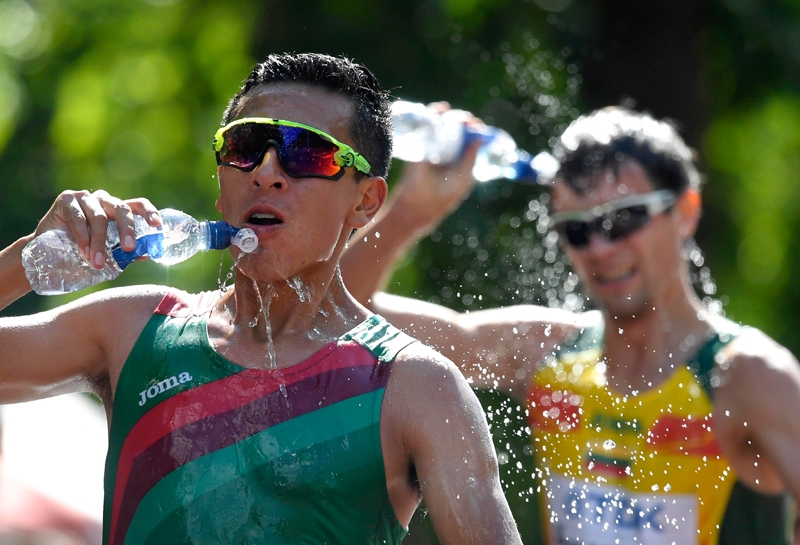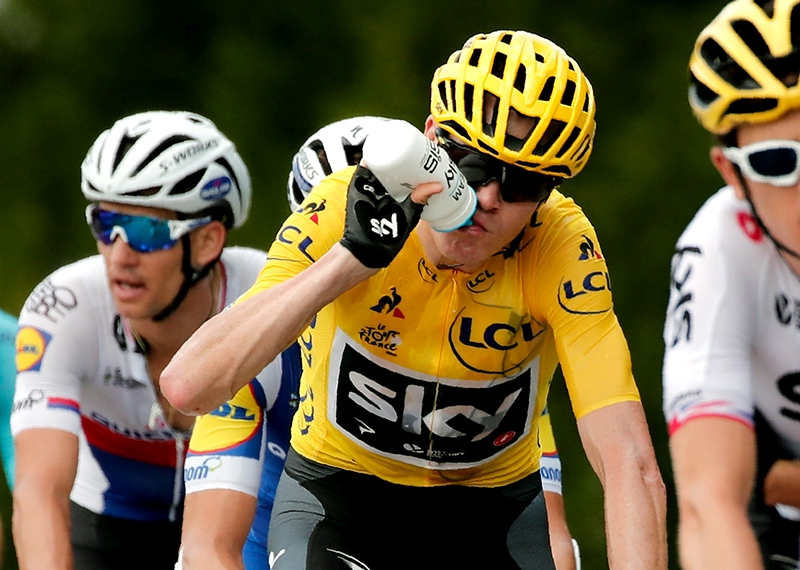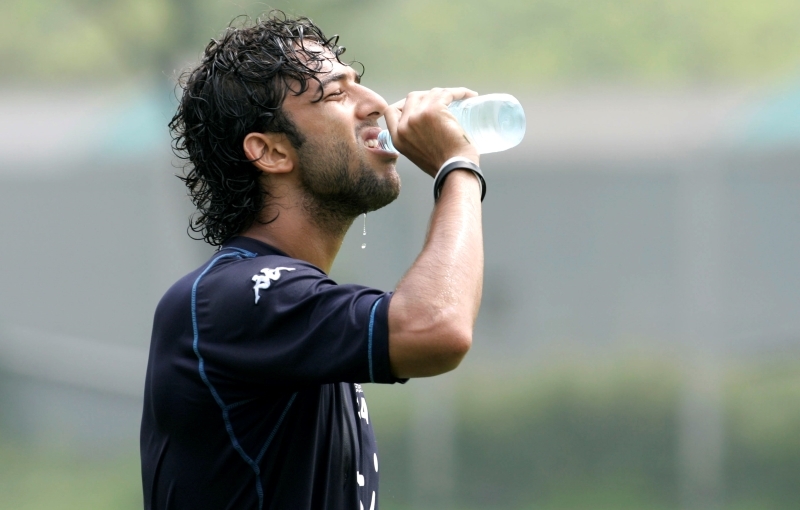You are viewing 1 of your 1 free articles. For unlimited access take a risk-free trial
Hot weather performance: cramp facts, cramp fiction

What really does determine muscle cramp risk in hot weather? SPB looks at new research
In the northern hemisphere at least, summer is approaching, which means that sportsmen and women in training and competition will need to think about coping with heat. As well as keeping hydrated, another major challenge is to avoid heat stress, which at the very least negatively impacts performance, and when severe, can represent a real threat to safety, particularly for athletes participating in longer-duration events(1). As well as fatigue and reduced performance resulting from it, another challenge for athletes performing in hot conditions is muscle-cramps, which may be an even more troublesome consequence than fatigue(2) and can ruin even the best planned race or training session!The problem with cramps
There are a number of strategies that athletes can use to combat the negative effects of training or racing in the heat, including acclimatizing the body to heat prior to the event (see this article), effective cooling methods (see here) and of course ensuring hydration needs are met (see this article). However, probably the trickiest issue to solve is the one of heat-associated muscle cramping. Although it’s a widely-held belief that poor hydration and electrolyte losses (exactly what happens when an athlete sweats during hot weather exercise) can significantly increase the risk of exercise-induced muscle cramps, the evidence for this in the literature is actually rather patchy.The truth about cramps
A study on cyclists looked at the effects of either mild dehydration (up to 3% of body mass) or severe dehydration (5%) of body mass on the incidence of muscle cramp susceptibility(3). It found that neither dehydration nor the level of exercise intensity affected the cyclists’ susceptibility to muscle cramps. Instead the researchers proposed that the neuromuscular system (motor neurons in control of muscle fibers) were more likely to determine the likelihood of cramp.These results reflect those from South African scientists who studied 72 runners competing in an ultra-distance marathon and compared data from those who suffered exercise-induce cramps and those who didn’t. Although there were small variations in blood levels of post-exercise sodium and magnesium, there were no clinically significant alterations in blood electrolyte concentrations and no alteration in hydration status in runners with exercise-associated muscle cramping (EAMC)(4).
Likewise, a comprehensive review study on this topic concluded that scientific evidence in support of the ‘electrolyte depletion’ and ‘dehydration’ hypotheses for the causes of EAMC came mainly from anecdotal clinical observations and case studies(5). However, the results from four cohort studies did not support these hypotheses. In addition, the researchers also argued that electrolyte depletion and dehydration hypotheses do not offer plausible pathophysiological mechanisms with supporting scientific evidence that could adequately explain the clinical presentation and management of EAMC.
The cramping threshold
Dehydration and low electrolyte levels do not in themselves appear to sufficient to cause exercise-associated muscle cramps. But could they provide the ‘background conditions’ for cramp, thus enabling cramp to occur when a neuromuscular trigger comes along? A brand new study by Australian and Japanese scientists looking into this topic has just been published in the Journal of the International Society of Sports Nutrition(6).In this study, researchers investigated the hypothesis that post-exercise muscle cramp susceptibility - measured by administering an electrical current to stimulate the motor neurons - would be affected by electrolyte levels and increased with spring water ingestion, but reduced with oral rehydration solution (containing electrolytes) ingestion during exercise. To do this, ten male runners performed downhill running in the heat (35-36°C) for 40-60 minutes on two occasions separated by a week. The goal was to induce dehydration via sweating, and downhill running was used to emphasize eccentric muscle contractions, which impose a higher loading on the muscles, making them more prone to cramps.
Both trials were identical apart from the drinks the runners consumed during each trial; in one trial they consumed an electrolyte drink while in the other they consumed plain spring water. The runners’ calf muscle cramping susceptibilities were assessed by determining the threshold of an electrical stimulation required to induce cramping. This testing was carried out before, immediately after, 30 minutes and 65 minutes after each downhill run. In addition, blood samples were taken at the same times to measure blood electrolyte levels (sodium, potassium, magnesium and chloride concentrations).
The findings
Before each downhill run, the electric stimulation threshold to induce muscle cramp was not significantly different. After the downhill running however, the stimulation threshold fell (ie muscles cramped more readily) when the runners had drink plain spring water but actually rose somewhat when the runners had consumed the electrolyte drink. In addition, blood levels of sodium and chloride fell slightly when the runners drank plain spring water but remained unchanged when the electrolyte drink was consumed.Implications for athletes
On the face of it, these results suggest that consuming an electrolyte drink (or fluid containing electrolytes) seems to help prevent muscles from being vulnerable to electric stimulation leading the cramps. But if that’s the case, why is the evidence for the protective effect of electrolytes against cramps seemingly lacking in the literature? One explanation might be that although a factor, electrolyte status does not actually determine whether cramping takes place – rather it’s the electrical stimulation patterns that are the real key.So what can affect electrical stimulation thresholds in muscles? Unfortunately, our understanding of this subject is poor, but most scientists agree that there are a number of factors determining this, some of which are set out in figure 1. Of particular importance may be genetics, increasing age, poorly-trained muscles and (linked to training) undue fatigue. One thing that nearly everybody agrees upon however is that a regular stretching program targeted at muscles prone to cramping can reduce the incidence of exercise associated muscle cramps as well as stopping cramp once it’s started(7,8).
Figure 1: Key factors involved in the etiology of muscle cramping

Another useful approach to help reduce the risk of muscle cramps may be to consume spicy, peppery foods before exercise (even several hours before)(9). The theory is that by applying a strong sensory input and stimulating receptors in the mouth and oesophagus, the pungent taste can ‘overload’ nerve receptors, producing a kind of numbing effect on the motor neurons, which makes them less susceptible to firing randomly (ie reducing cramp risk). To read more about this theory and the research behind it, readers are directed to this article.
Other recommendations include building training intensity gradually; since the central nervous system plays a significant role in the aetiology of muscle fatigue during exercise, this almost certainly explains why unaccustomed fatigue greatly increases the risk of muscle cramps. Finally, athletes who suffer from recurrent cramps in one particular muscle group, should consider carrying out some strength training for the relevant muscles. Higher levels of strength can delay the onset of local muscle fatigue by lifting the ‘threshold’ at which fatigue is experienced.
References
- J Am Coll Cardiol. 2014 Aug 5;64(5):463-9
- J Athl Train. 2019 Jan;54(1):55-63
- Br J Sports Med. 2013 Jul;47(11):710-4
- Br J Sports Med. 2004 Aug;38(4):488-92
- Br J Sports Med. 2009 Jun;43(6):401-8
- J Int Soc Sports Nutr. 2021 Mar 15;18(1):22
- J Sports Sci 1997 Jun;15(3):277-85
- Clin Sports Med 2008 Jan;27(1):183-94, ix-x
- Neurology April 6, 2015 vol. 84 no. 14 Supplement S17.003
Newsletter Sign Up
Testimonials
Dr. Alexandra Fandetti-Robin, Back & Body Chiropractic
Elspeth Cowell MSCh DpodM SRCh HCPC reg
William Hunter, Nuffield Health
Newsletter Sign Up
Coaches Testimonials
Dr. Alexandra Fandetti-Robin, Back & Body Chiropractic
Elspeth Cowell MSCh DpodM SRCh HCPC reg
William Hunter, Nuffield Health
Keep up with latest sports science research and apply it to maximize performance
Today you have the chance to join a group of athletes, and sports coaches/trainers who all have something special in common...
They use the latest research to improve performance for themselves and their clients - both athletes and sports teams - with help from global specialists in the fields of sports science, sports medicine and sports psychology.
They do this by reading Sports Performance Bulletin, an easy-to-digest but serious-minded journal dedicated to high performance sports. SPB offers a wealth of information and insight into the latest research, in an easily-accessible and understood format, along with a wealth of practical recommendations.
*includes 3 coaching manuals
Get Inspired
All the latest techniques and approaches
Sports Performance Bulletin helps dedicated endurance athletes improve their performance. Sense-checking the latest sports science research, and sourcing evidence and case studies to support findings, Sports Performance Bulletin turns proven insights into easily digestible practical advice. Supporting athletes, coaches and professionals who wish to ensure their guidance and programmes are kept right up to date and based on credible science.













